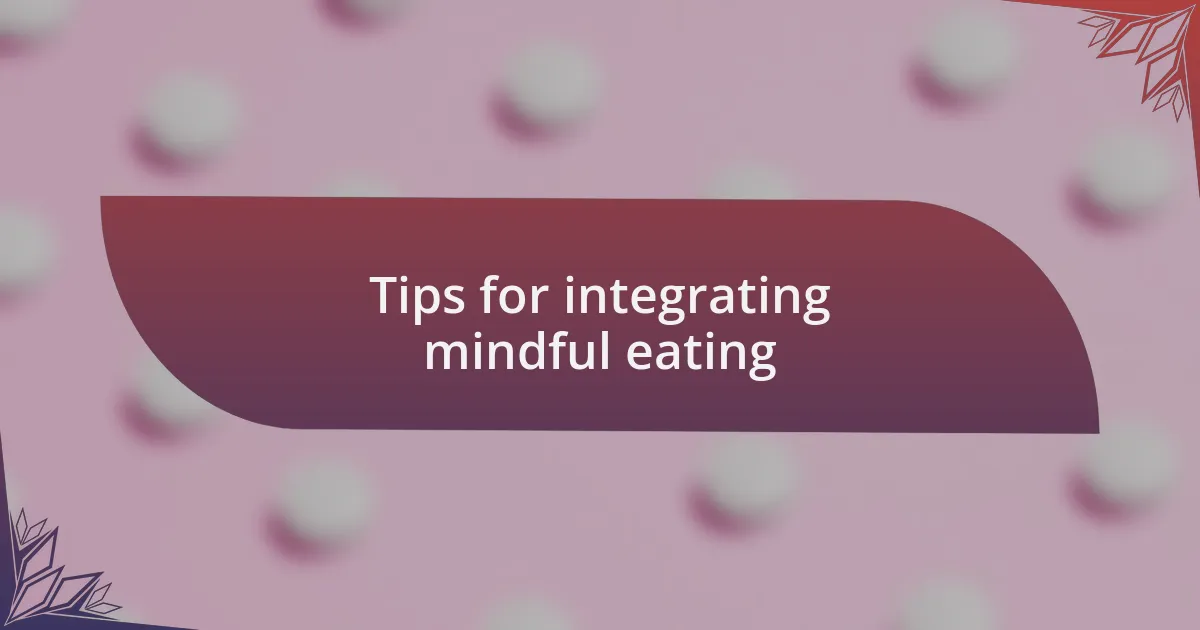Key takeaways:
- Mindful eating involves being present during meals, enhancing awareness of hunger cues, and cultivating a non-judgmental attitude towards food.
- This practice helps reduce unhealthy eating patterns, promotes gratitude for meals, and fosters healthier food choices.
- Strategies for mindful eating include eliminating distractions, engaging all senses, and reflecting on food choices through journaling.
- Challenges like distractions, social dynamics, and emotional eating can complicate the practice, requiring ongoing mindfulness and self-awareness.

Definition of mindful eating
Mindful eating is the practice of being fully present while you eat, which encourages awareness of the sensations and emotions associated with food. I remember a time when I sat down to a simple meal, and instead of rushing through it, I focused on each bite. I felt the texture, tasted the flavors, and noticed my feelings of hunger and satisfaction. Doesn’t that sound like a more fulfilling way to enjoy a meal?
At its core, mindful eating invites you to slow down, pay attention, and savor your food. It’s about listening to your body’s cues—are you hungry, satisfied, or even full? I often find myself reflecting on how often I eat mindlessly, distracted by screens or conversations. Have you ever noticed how this can lead to overeating or a lack of enjoyment in the food itself?
Additionally, mindful eating encourages a non-judgmental attitude toward food choices. It allows you to cultivate a healthier relationship with what you eat and helps you appreciate the nourishment your meals provide. I’ve experienced profound changes in my eating habits simply by adopting this approach, and it often leaves me feeling more connected to my food and, ultimately, to myself. Isn’t it fascinating how a simple shift in focus can transform our eating experience?

Importance of mindful eating
Mindful eating is vital for fostering a healthy relationship with food and our bodies. I recall a time when I ate while working—a common habit that left me unsatisfied, even after finishing a substantial meal. Have you ever felt that disconnect, where you eat a lot but still feel hungry? This practice helps bridge that gap by enhancing our awareness of hunger cues and emotional triggers associated with eating.
Incorporating mindfulness into my meals has significantly reduced my anxiety around food choices. When I focus on what I’m eating, I can appreciate the flavors and textures without judgment. This approach not only nourishes my body, but it also nurtures my mind, allowing me to enjoy my meals without the guilt that often comes with indulgence. How freeing it is to realize that food can be both enjoyable and healthy at the same time!
Moreover, mindful eating can help combat unhealthy eating patterns, such as binge eating or emotional eating. By bringing attention to each bite, I’ve found that I become more in tune with my body’s signals, making it easier to stop when I’m full. Imagine taking that time to truly connect with your meal, savoring each taste while learning to respect your body’s needs—what a rewarding experience that is!

Benefits of mindful eating
Mindful eating offers numerous benefits that extend far beyond the dinner plate. I’ve realized that by truly paying attention to what I’m consuming, I not only enjoy my meals more but also tend to make healthier choices. Have you ever noticed how a meal feels different when you eat it slowly and with intention? It’s almost like your body and mind come together in harmony, making it easier to choose nutritious options instead of reaching for that bag of chips out of habit.
One significant advantage I’ve experienced is a decrease in overeating. When I focus on each bite, I’m more attuned to my body’s signals. There was a time when I would mindlessly finish my plate regardless of my hunger level. But now, I often pause to assess my fullness, which has been liberating. Honestly, it feels empowering to listen to my body and respond accordingly rather than relying on external cues, like portion sizes.
Additionally, I find that mindful eating fosters a deep sense of gratitude. Each meal transforms into an opportunity to appreciate both the food and the moment. I remember a dinner where I took the time to reflect on the ingredients and their journey to my table. This practice cultivates a sense of connection—not just to the food but to the people and the culture surrounding it. How often do we stop and truly appreciate the meal before us? Embracing this awareness enriches my overall dining experience, creating a beautiful relationship with food.

Strategies for mindful eating
To cultivate mindful eating habits, I recommend starting with a simple practice: put away distractions during meals. I used to catch up on my favorite shows while eating, barely noticing what was on my plate. Now, I sit at the table without my phone or TV, and it’s incredible how the flavors come alive when I truly focus on them.
Another effective strategy is to engage all your senses while eating. For instance, I used to rush meals, but now I take a moment to appreciate the colors, textures, and smells of my food. Have you ever savored a dish until every bite felt like an experience? This not only increases my enjoyment but also helps me recognize when I’m satisfied.
Lastly, I find that setting an intention before each meal enhances my awareness. I might tell myself, “I’m going to enjoy every bite and appreciate where this food comes from.” This small mental shift encourages me to be present in the moment. It’s fascinating how such a straightforward practice can transform my approach to food and nourish my overall well-being.

Personal experiences with mindful eating
Mindful eating has brought a remarkable change in my relationship with food. I remember a time when dinner felt like just another item on my to-do list. Now, as I sit quietly with my meal, I’m surprised at how much more connected I feel—not just to the food itself, but to my body’s signals and cravings.
One evening stands out. I made a colorful salad packed with fresh vegetables. Instead of mindlessly chomping away, I paused between bites to notice the crunchiness of the cucumbers and the sweetness of the bell peppers. I recall thinking, “How did I miss this before?” That moment of realization made me appreciate not only the meal but also my journey toward being more present during mealtime.
There are tough days, too. Sometimes, I find myself slipping back into old habits, eating hurriedly while multitasking. But when that happens, I remind myself that mindfulness is a practice, not a perfect. Catching myself in those moments often makes me laugh and inspires me to re-center. How have you navigated those slip-ups? I’ve learned to treat them as chances to reconnect with my mindful eating journey.

Challenges in practicing mindful eating
Practicing mindful eating isn’t always easy. One challenge I often face is the constant presence of distractions, like my phone buzzing with notifications or a tempting TV show in the background. Have you ever tried to enjoy a meal while scrolling through social media? I find it pulls me away from the flavors and textures of my food, making it harder to listen to my body’s cues.
Another hurdle I’ve encountered is the social aspect of meals. Dining with friends or family can be wonderful, yet it sometimes leads to rushed eating. I remember sharing a potluck dinner where everyone was chatting excitedly. I noticed I was eating faster to keep up with the conversation, which detracted from my ability to savor the meal. Isn’t it fascinating how much our eating habits can change with the dynamics of those around us?
Then there are emotional eating triggers that can sneak up on me. I often reach for snacks when I’m stressed or bored, even if I’m not physically hungry. Lately, I’ve been trying to pause and ask myself, “Am I really hungry, or am I eating out of habit?” It’s a tough question, but addressing it has opened my eyes to the emotional connections I have with food, making the journey of mindful eating even more complex but rewarding.

Tips for integrating mindful eating
One effective tip for integrating mindful eating is to create a designated eating space that’s free from distractions. I’ve discovered that when I sit down at a table, sans my phone or any screens, I can focus entirely on my meal. Have you ever noticed how your senses come alive when you actually pay attention? The aroma, the colors, and the textures become so much more vivid.
Another strategy I find invaluable is to pause before each bite. I try to set my fork down between bites and take a moment to savor what I’m eating. This practice helps me truly enjoy my food and allows me to check in with my body about hunger and fullness. In moments of reflection, I often ask myself, “What do I really feel like eating right now?” It’s amazing how this simple act can transform the whole experience into something more meaningful.
Lastly, I recommend keeping a food journal. I started recording not just what I eat, but also how I feel before and after meals. At first, it felt tedious, but it quickly became enlightening. I began to recognize patterns and triggers, helping me understand my relationship with food better. Have you tried this? It can be a powerful tool for self-discovery and enhance your mindful eating journey.